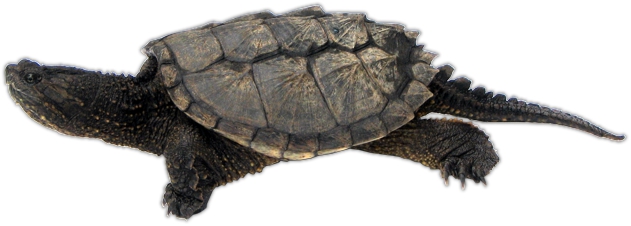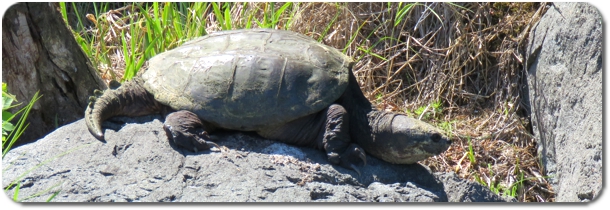Common Snapping Turtle
What it looks like
The Common Snapping Turtle is a large turtle. They can grow to have a shell length of up to 50 cm, but most adults are around 30 cm in shell length. Males are larger than females. Large adults are often weigh more than 15 kg. The record in North America for Common Snapping Turtles is 35 kg! With the neck and tail stretched out the total length can be twice the length of the shell. Adults are dark brown in colour. Hatchlings are dark brown to black with white spots or markings on the underside.
Look-alikes
There are only two kinds of turtles in Manitoba. Common Snapping Turtles are usually much larger than Western Painted Turtles. They have rough edges to their shells, long tails and necks, and are dark brown all over. Western Painted Turtles have smooth shells, short tails and bright coloured stripes on their heads and necks and a bright coloured belly.
Name
Common Snapping Turtles get there name by their habit of snapping their jaws quickly to catch prey or to defend themselves. They are more common than the other kinds of snapping turtles in North and South America.
Scientific Name
The Common Snapping Turtle's scientific name is Chelydra serpentina. Learn what that means on this page: Scientific Names.
Where it lives
Snapping Turtles can be found in eastern North America as far north as southern Canada. They live in large ponds, rivers and lakes.
Where Common Snapping Turtles live in North America.
Habits
Common Snapping Turtles walk or swim along the water bottom looking for food, or they hide along the water's edge waiting for fish or other animals to come near them. They will crawl out of the water to bask on sunny days to warm up. In Manitoba they are active from April to October.
They spend winter on the bottom of large ponds, lakes or rivers. Once there is ice on the water they must stop moving around as they can't get to the surface to breath air. In cold water they get oxygen through their skin. Common Snapping Turtles sometimes move from large water bodies to smaller ponds in the summer to feed, then return to the larger water bodies for winter.

A Common Snapping
Turtle basking.
Food Web
Common Snapping Turtles eat fish, aquatic insects and some kinds of water plants. They can catch live animals with their snapping jaws, but will eat any dead animals they find, too.
Adults don't have many enemies as long as they don't go too far from water. They are too big to be eaten by fish, birds or even raccoons. Young turtles are eaten by large fish, birds such as herons and egrets, and mammals like raccoons, skunks and minks.
Life Cycle
Common Snapping Turtles mate in May and females lay eggs in June. They dig a nest in sandy or loose soils and lay around 20 - 40 eggs. The eggs hatch in early September to early October. Babies are only about 6 - 7 cm long, nose to tip of tail, at hatching. They need 4 or 5 years to grow to adult size and can live for more than 50 years.
Numbers
Snapping Turtles are common in southern Manitoba, but the numbers that might live in a lake or stretch of river aren't known.
Special Things
This is our largest reptile and one that is best left alone! Common Snapping Turtles will bite fiercely to defend themselves. The bite of a large Snapping Turtle could cut off a finger.
How to Find Common Snapping Turtles
These turtles can be seen basking along the edges of water bodies. They are more difficult to spot than a Western Painted Turtle because of their darker colour and "rock-like" appearance. From late May to early July they can be seen crossing roads as they move from one water body to another, or females search for nest sites.
Use by People
In some parts of North America people hunt Common Snapping Turtles to eat them. In Manitoba they are not hunted.
| Go to: Western Painted Turtle | Go back to: Amphibians and Reptiles Front Page |
